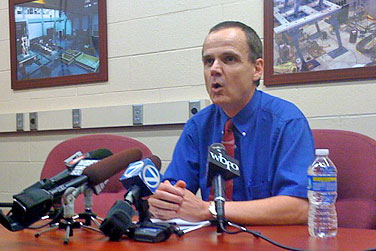News
Quake small, but still significant

Andre Filiatrault talks to the media at a news briefing held in Ketter Hall about 90 minutes after the earthquake occurred. Photo: JOHN DELLACONTRADA
-
 Print
Print -
 Comments
Comments
-
“This basically reminds us we are in a seismic zone; an earthquake can occur pretty much anywhere in North America.”
Did you feel it?
That was the prevailing question yesterday at UB and elsewhere in Western New York as the region felt the effects of a moderate earthquake in Canada.
The epicenter of the magnitude 5 trembler, which occurred at 1:41 p.m., was along the border of Ontario and Quebec, near the city of Buckingham, about 30 miles east of Ottawa. That’s about 250 miles from Buffalo.
“This basically reminds us we are in a seismic zone; an earthquake can occur pretty much anywhere in North America,” said Andre Filiatrault, director of MCEER, UB’s earthquake engineering and extreme events research center, and professor of civil, structural and environmental engineering. He noted that the earthquake was not unusual, as it was located in the Ottawa Valley, one of five major seismic zones in Canada.
During an earthquake, there is a sudden release of energy in the Earth’s crust, “very similar to dropping a rock in water, with waves that emanate,” he explained to a smattering of journalists at a hastily called news conference in Ketter Hall.
“What we’re feeling is waves shaking, moving away from the epicenter and making the ground vibrate,” Filiatrault said. The fact that the quake was felt relatively strongly in Buffalo—250 miles from the epicenter—is characteristic of the earth’s crust in eastern North America, he said. The geological formation, called the Canadian Shield, “is a very old and compacted geological formation; the earth’s crust is very, very compacted and that causes the wave to travel a very long distance,” he said, adding that this is characteristic of earthquakes in eastern North America, unlike those on the West Coast.
“So if you have an earthquake in California, for example, the wave, or shaking, will attenuate very quickly, so within, say 50 to 100 miles, you won’t feel anything. This earthquake occurred 250 miles away and we felt it in Buffalo and we have reports that it was felt as far away as Columbus, Ohio. The footprint, of earthquake in terms of shaking is much larger distance than on the West Coast, and this is an issue that we have to deal with in eastern North America.”
Filitrault said that as of early yesterday afternoon, there were reports of only minor damage in Ottawa from the quake. He noted that yesterday’s earthquake was the strongest in the region since the magnitude 6 Saguenay earthquake in Quebec in 1988, which also was felt in Western New York and as far south as Washington, D.C. And there have been other “significant” earthquakes, he said, including the magnitude 7 quake in Quebec City in 1925. Moreover, in 1763, the Jesuits reported a major earthquake in Montreal that collapsed more than 300 houses, he said.
“There have been earthquakes in the past,” he said. “They don’t occur that often, but the potential for damage is there, so we have to recognize that.”
Even though yesterday’s earthquake did not cause the kind of damage that prompts UB earthquake engineers to jump on a plane and travel to the site, the event was still important to researchers.
“Every time there is an earthquake, it is significant for us because it becomes a piece of information” that can help researchers determine how buildings and other infrastructure might fare under those conditions at that location, he said, pointing out that the “motion” of the quake can be fed into MCEER’s computer system and that shaking can be reproduced with the center’s two shake tables, Filiatrault said. “It adds to the databank of information,” he said.
Moreover, it also is important for seismologists. “The basis of design for earthquakes is to have a good idea where earthquakes occur and what the shaking will look like”—a concept called seismic hazard analysis, which is based on statistical analysis of data. There is not a lot of this kind of data available for eastern North America, relative to the West Coast, he said, so data from yesterday’s event “may influence…the seismic maps in the next editions of the code, which will have an influence on how buildings are designed in eastern Canada, and eastern North America in general.”
Did Filiatrault feel it?
“I was in Clarence; I didn’t feel anything.”

Reader Comments